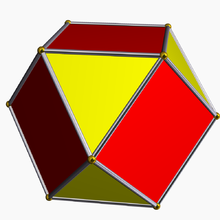
Back Rektigo (geometrio) Esperanto Rectificación (geometría) Spanish Rectificare (geometrie) Romanian Полное усечение (геометрия) Russian Rektifikacija (geometrija) Slovenian 截半 (幾何) Chinese



In Euclidean geometry, rectification, also known as critical truncation or complete-truncation, is the process of truncating a polytope by marking the midpoints of all its edges, and cutting off its vertices at those points.[1] The resulting polytope will be bounded by vertex figure facets and the rectified facets of the original polytope.
A rectification operator is sometimes denoted by the letter r with a Schläfli symbol. For example, r{4,3} is the rectified cube, also called a cuboctahedron, and also represented as . And a rectified cuboctahedron rr{4,3} is a rhombicuboctahedron, and also represented as .
Conway polyhedron notation uses a for ambo as this operator. In graph theory this operation creates a medial graph.
The rectification of any regular self-dual polyhedron or tiling will result in another regular polyhedron or tiling with a tiling order of 4, for example the tetrahedron {3,3} becoming an octahedron {3,4}. As a special case, a square tiling {4,4} will turn into another square tiling {4,4} under a rectification operation.
© MMXXIII Rich X Search. We shall prevail. All rights reserved. Rich X Search

